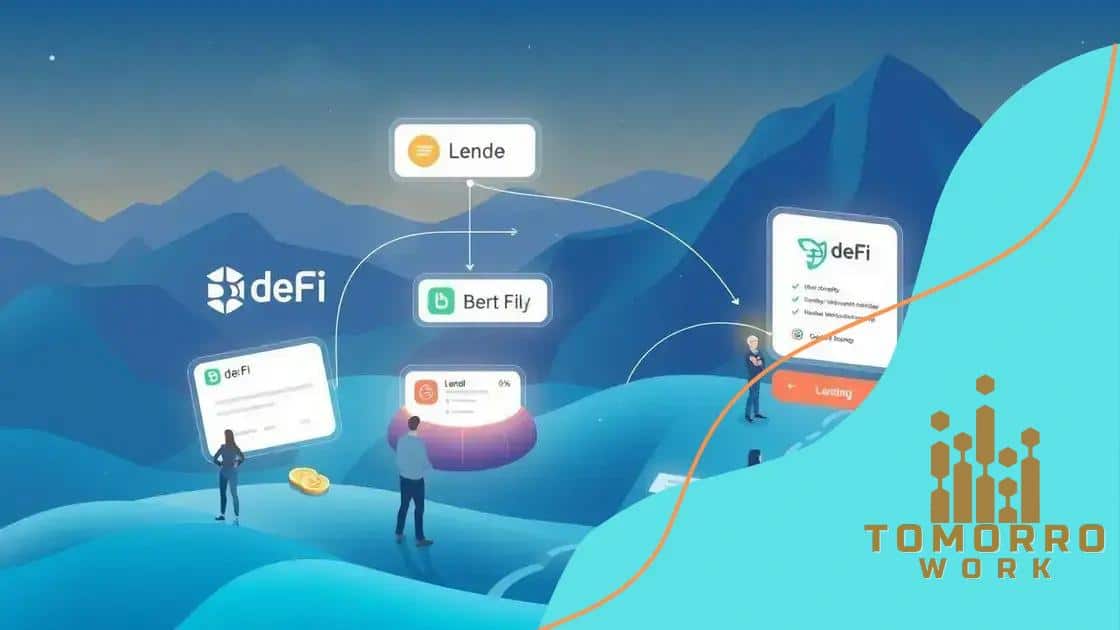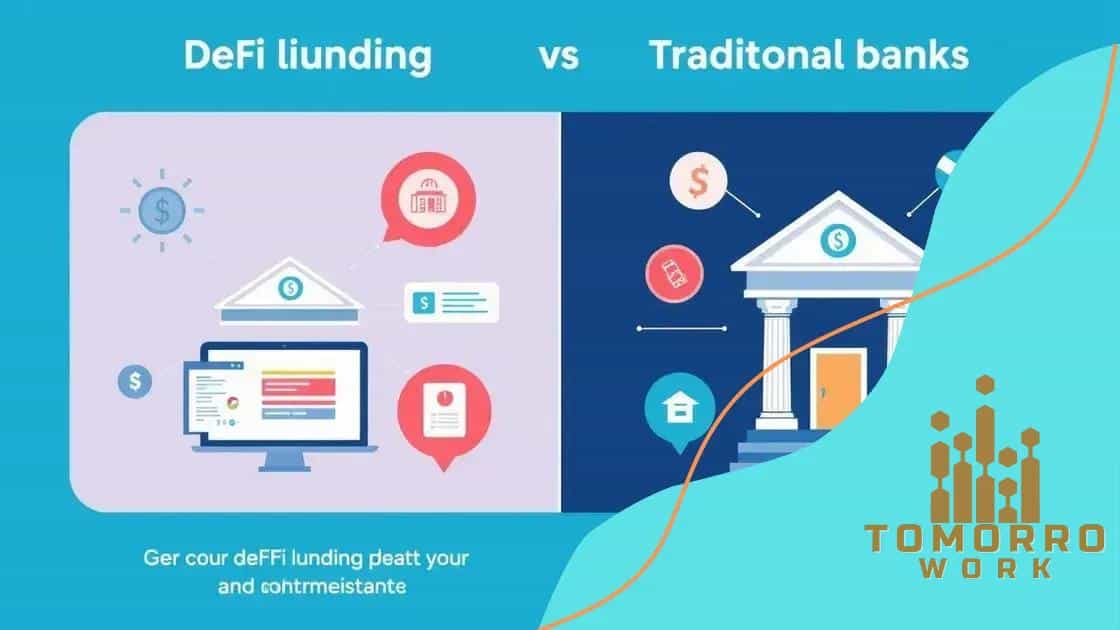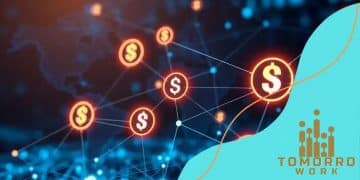How decentralized finance (DeFi) platforms are transforming lending

Advertisements
Decentralized finance (DeFi) platforms are transforming lending by enabling direct peer-to-peer transactions, reducing fees and barriers, and introducing innovative features like smart contracts and liquidity pools.
How decentralized finance (DeFi) platforms are transforming lending is a question gaining traction in financial discussions. Have you wondered how these platforms can challenge traditional lending models? Let’s dive in and explore the innovative changes they bring.
Advertisements
Understanding decentralized finance and its principles
Decentralized finance, often known as DeFi, is changing the way we think about financial services. It operates without traditional banks, offering new opportunities for everyone. With DeFi, users can trade, lend, and borrow directly with one another.
Core Principles of DeFi
The principles of decentralized finance are essential to its operation. Unlike conventional finance, DeFi aims to provide open access and transparency in financial transactions.
Each transaction in DeFi operates on a public ledger, ensuring that activities are transparent and verifiable. This transparency builds trust among users. DeFi platforms offer unique opportunities to earn high interest on cryptocurrency deposits, allowing users to engage without intermediaries.
Advertisements
How DeFi Works
DeFi uses various technologies to create financial applications. These include decentralized exchanges (DEXs), lending platforms, and liquidity pools. By leveraging blockchain, DeFi eliminates the need for traditional banks.
Users trade cryptocurrency using smart contracts, which execute transactions automatically. These contracts function based on rules set by users, reducing risks and ensuring compliance. Furthermore, DeFi significantly lowers transaction fees compared to traditional banks.
As DeFi continues to grow, its impact on finance becomes undeniable. It opens doors to innovation and provides users with more control over their personal finances. The future of finance is shifting, making decentralized finance an exciting area to watch as we explore these new pathways.
Key features of DeFi lending platforms
DeFi lending platforms have unique features that differentiate them from traditional lending systems. One major aspect is their decentralization. This means no central authority controls the transactions. Borrowers and lenders connect directly, which enhances trust and reduces fees.
Pooling Resources
Another key feature is resource pooling. DeFi platforms allow users to combine their assets into liquidity pools. These pools facilitate lending without relying on a banking institution. Users can deposit various cryptocurrencies and earn interest over time.
A further advantage is the transparency of blockchain technology. Every transaction is recorded on a public ledger which enhances trust among participants. Users can verify the terms of the loan and ensure that everything is fair. Low fees are another benefit enjoyed by users, as many platforms do not charge high interest rates compared to traditional banks.
Smart Contracts
Smart contracts play a vital role in these platforms. They automate the lending process and handle agreements between parties. This automation allows for fast transactions while also minimizing human error. Users set their loan conditions, ensuring a customized experience based on their needs.
As DeFi lending platforms grow, they offer more features and better user experiences. The flexibility, transparency, and automation found in these platforms are reshaping the landscape of personal finance.
Comparing DeFi lending to traditional models

When comparing DeFi lending to traditional lending models, several key differences emerge. Traditional banks typically serve as intermediaries, controlling transactions and setting fees. This can create barriers for borrowers. In contrast, DeFi lending platforms enable direct transactions between users, which fosters lower fees.
Flexibility and Accessibility
A major advantage of DeFi is the flexibility it offers. Users can engage with multiple platforms without needing to set up accounts with banks. Additionally, DeFi lends itself to a more accessible system where anyone with an internet connection can participate.
In traditional lending, loans often require credit checks, which can limit options for many. DeFi lending eliminates these barriers by focusing on collateral before loan approval instead. This approach allows users with less-than-perfect credit history to access funds.
Speed of Transactions
The speed of transactions in DeFi lending cannot be overstated. Loans can be processed within minutes on a DeFi platform, while traditional banks might take days. The seamless, automated nature of DeFi transactions enhances user experience significantly.
Moreover, transparency is a hallmark of DeFi. All transactions are recorded on a public ledger, making it easier for participants to verify the terms and their history without confusion. Traditional models, while stable, may lack this level of transparency.
Ultimately, the choice between DeFi lending and traditional lending depends on individual preferences. Each model has its own set of advantages and challenges. Understanding these differences can help users make informed decisions about their financial interactions.
Risks and challenges in DeFi lending
While DeFi lending offers many advantages, it also comes with its own set of risks and challenges that users should consider. One significant risk is the potential for smart contract vulnerabilities. If a smart contract is poorly coded, it can be exploited by hackers, leading to significant financial losses for users.
Market Volatility
Another challenge in DeFi lending is market volatility. The value of cryptocurrencies can change rapidly, which impacts the collateral used for loans. Users may find themselves in a situation where their collateral is worth less than expected, triggering liquidation.
Furthermore, the lack of regulation in the DeFi space can expose users to scams and fraudulent projects. Unlike traditional finance, where regulatory bodies provide oversight, DeFi operates in a more ambiguous environment. Users must perform thorough research before using platforms.
Understanding Liquidation Risks
Liquidation is another key risk that users need to understand. If the value of a user’s collateral falls below a certain threshold, their collateral may be automatically sold to cover the loan. This can lead to users losing a significant portion of their investments.
Finally, connectivity issues may pose a problem. Sometimes, bad internet or platform downtime can prevent users from accessing their funds when needed. Having a reliable setup is essential for effective participation in DeFi lending.
In summary, while the risks in DeFi lending can be substantial, understanding them allows users to navigate the landscape more safely. With the right knowledge and preparation, users can mitigate these challenges and take advantage of the benefits that DeFi lending provides.
Future trends in decentralized finance lending
Future trends in decentralized finance (DeFi) lending are poised to reshape the financial landscape significantly. As technology evolves, new features and capabilities will emerge, allowing for more efficient and accessible financial solutions. One trend to watch is the rise of AI integration in DeFi platforms. This technology can enhance lending processes by providing better risk assessment and personalized loan offerings.
Increased Security Measures
As the DeFi ecosystem grows, the focus on security will intensify. Users can expect more advanced security protocols to protect their assets. Platforms will likely implement better auditing processes and insurance protections for deposits, making the environment safer.
Another anticipated development is the expansion of cross-chain lending. DeFi platforms may start to support multiple blockchains, allowing users to lend and borrow assets across different networks. This enhances flexibility and opens the door to more diverse investment opportunities.
Interoperability Between Platforms
Interoperability is a significant focus area. Efforts to create seamless integration among various DeFi applications will simplify user interactions and enhance overall efficiency. Users will find it easier to manage their assets across different platforms, facilitating smoother transactions.
On the regulatory front, as DeFi continues to attract attention, there may be new regulations emerging. This could help to legitimize the sector while also introducing challenges for existing platforms. Compliance with regulations might lead to enhanced trust among users and mainstream adoption.
Lastly, the focus on sustainability will grow steadily. DeFi platforms will likely explore environmentally friendly practices, such as using green energy for operations. As awareness of environmental issues rises, users may prefer platforms committed to sustainability.
In summary, the future of decentralized finance lending looks promising as trends point to increased security, interoperability, regulatory oversight, and sustainability. By staying informed about these trends, users can be better prepared to navigate the evolving landscape of finance.
In this exploration of decentralized finance (DeFi) lending, we’ve uncovered its innovative features, compared it to traditional models, and addressed the risks involved. As the DeFi landscape evolves, users will see exciting changes driven by technology, accessibility, and sustainability. Staying informed will empower users to navigate this dynamic financial landscape effectively. The future of DeFi lending continues to promise opportunities that can transform personal finance.
FAQ – Frequently Asked Questions about DeFi Lending
What is DeFi lending?
DeFi lending is a decentralized finance solution that allows users to lend and borrow cryptocurrencies directly without intermediaries like traditional banks.
What are the main advantages of DeFi lending?
The main advantages include lower fees, faster transactions, and increased accessibility for users around the world, allowing anyone with an internet connection to participate.
Is DeFi lending safe?
While DeFi lending offers many benefits, it comes with risks such as smart contract vulnerabilities and market volatility. Users should conduct thorough research before participating.
How can I mitigate risks in DeFi lending?
To mitigate risks, users should diversify their investments, monitor their collateral value regularly, and stay informed about market trends and security updates.





